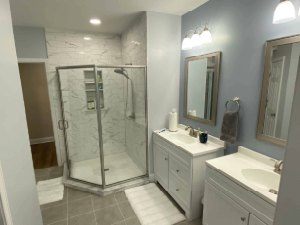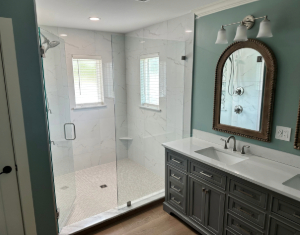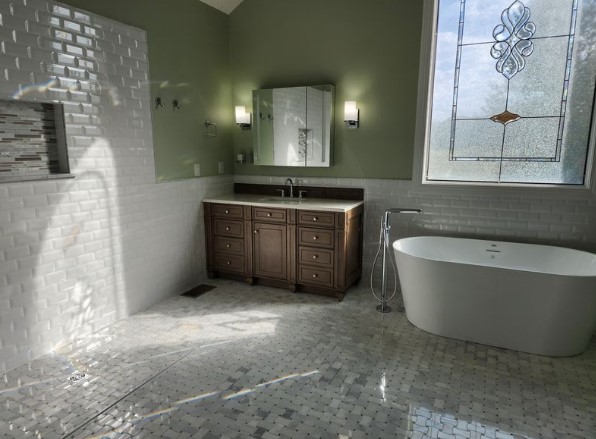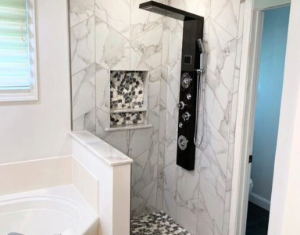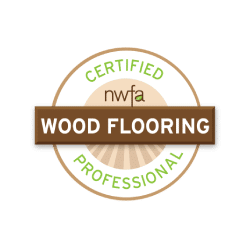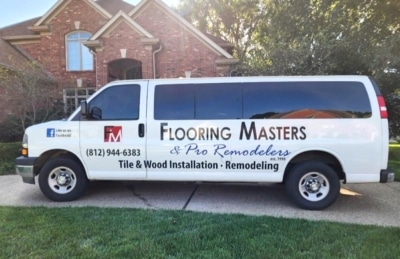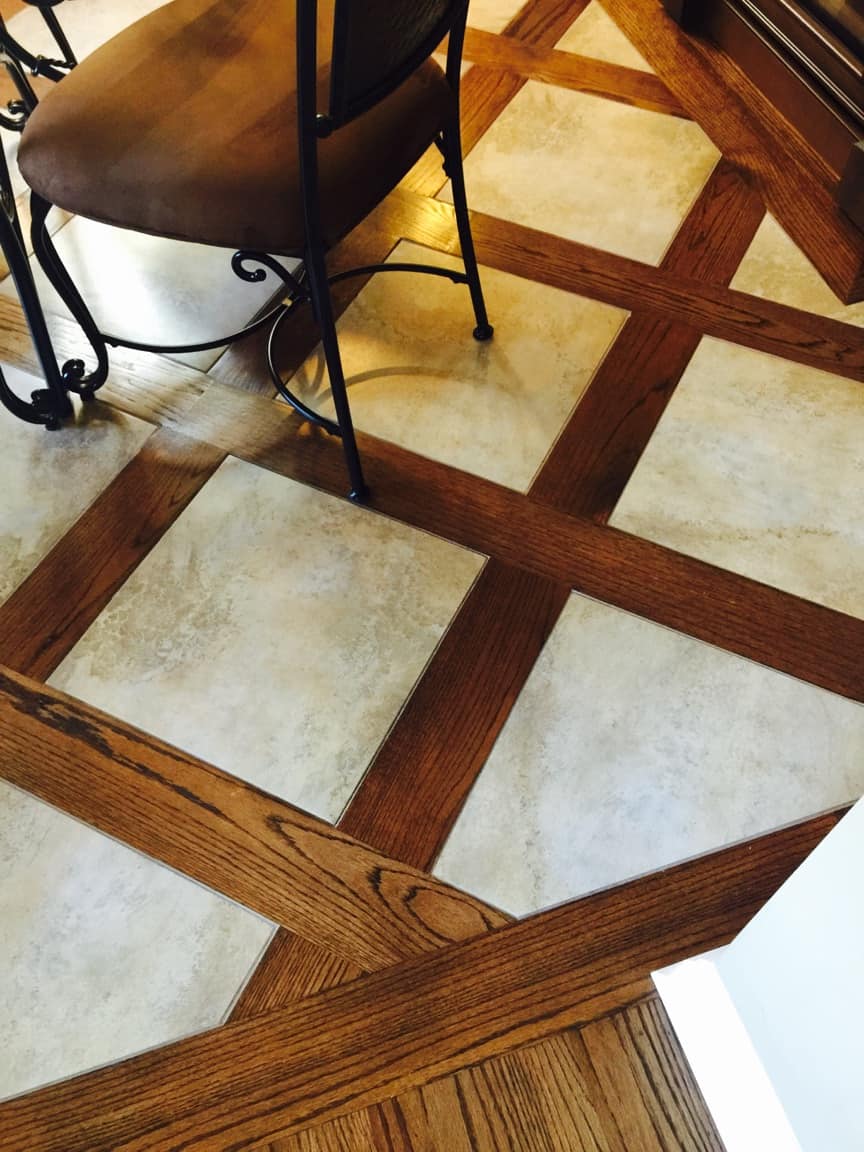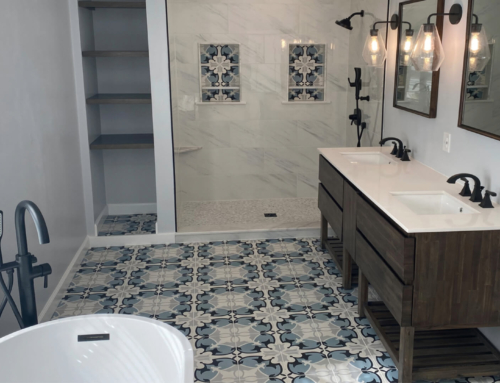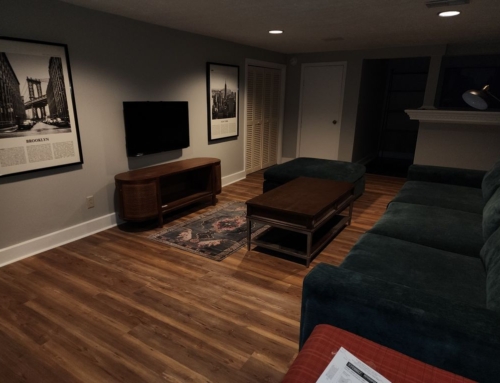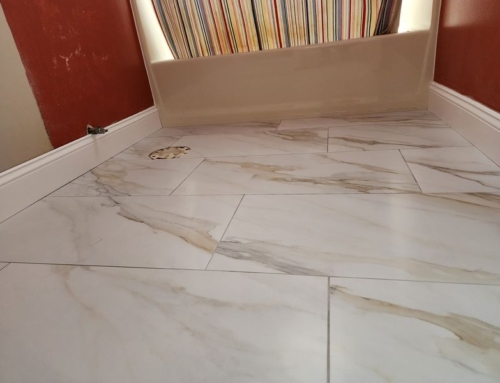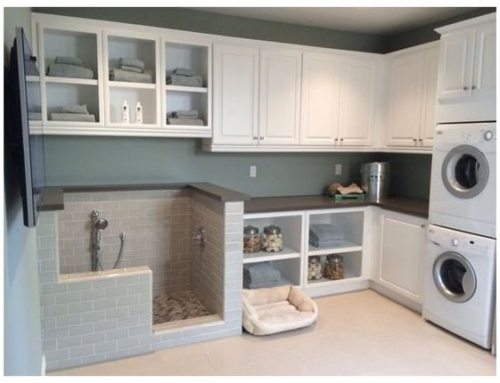Can’t decide between wood floors or tile? Ceramic or vinyl? Natural stone or engineered wood? If you want to get ultra-creative with your floor design, you don’t have to choose one over the other—you can have both! “Mixed media” is becoming more and more popular in the flooring industry. Designs featuring wood floors with tile or stone can be woven together to create a unique design.
Your imagination is the only limit when combining hardwood with stone or ceramic, although the most popular look is what is called a “weave.” That’s when you create a basket weave-style pattern by placing large square tiles one wood plank’s width apart from each other, and enclose them in hardwood or hardwood-inspired flooring, such as luxury vinyl plank or engineered wood.
Choosing Your Materials
To choose and install the right materials, it’s important to know how each one functions in order to ensure a successful installation that doesn’t develop problems down the road. For example, wood and water do not mix well, yet the components for an adjacent decorative surface such as stone and tile require using water during the installation procedure, in the grout, for example.
Attention to detail is another important key. Tile should be set first, with hardwood installed after the quickset is dry. This can complicate the installation process, as the grid pattern must be perfectly square it’s time to install the hardwood, or else the entire design is compromised.
Also, tile and stone can have different vertical heights compared to whatever hardwood you choose to match it. This makes planning extra important, or else you’ll end up with a botched, amateur-looking job. Your installer must measure carefully to make sure the finished floor is as perfectly level as it would be if they used the same material throughout.
Other popular forms of mixed media include stone medallions and borders. Many of these are preassembled and don’t rely on the difficulty of fitting of wood floors into the design, as everything is pre-matched. Usually they are glued into place during or after the hardwood installation, once the design area is cut out. That’s not to say such floors don’t require planning—any time you venture outside of single-material flooring designs you have to be sure to have a gameplan.
Stone combined with wood flooring has been used as a flooring design for centuries. Because stone has different properties than wood, installation applications differ, specifically with allowing expansion spacing.
Depending on the source, some medallions may be made specifically for inset into ceramic tile or stone, where the overall thickness will be 3/8 of an inch. Depending on the size, some may be fully intact or arranged in sections for safer shipping. While this thickness is ideal for standard engineered floors that may be glued to concrete, we’re left with another 3/8-inch if you want to install over a wood subfloor system with ¾-inch hardwood.
In the case of using solid floors with thinner medallions, a concrete backer board is recommended. Some manufacturers offer thickness options for their designs if installing into floors from 3/8- up to 3/4-inch. Essentially, a plywood backer board is attached to the design that can be pre grouted or not, leaving the final grouting and color selection up to the buyer on the jobsite.
However, using these materials along with wood floors requires an expansion area. By not using one, the natural expansion of hardwood against these materials is likely to cause cracking because of the outward force. The force of moisture with wood and stone has been known for centuries. In fact, it was a method used to split large sections of stone in ancient times.
Friend or Faux?
Another option with far less tricky installation would be to use tile throughout but mix and match tile that looks like traditional tile with tile that is made to emulate wood.
If you think you’ve never seen a faux wood tile floor, you may have walked right on one without even realizing it. Faux-wood tile floors not only give you the look of wood, but also the durability of tile.
It’s exactly what you would imagine: porcelain or ceramic tile that looks just like wood. These types of flooring are quite versatile, and come in a variety of patterns and styles, including a wood grain tile texture. Having faux wood tiles mean that you get the beauty of hardwood floors without all the hassle and maintenance that comes with it.
Something you can do very easily with faux wood tiles is customizing the look. When you have a variety of tiles, colors, grains, and sizes at your disposal, you can truly create the floor of your dreams. Using these tiles, you can make all sorts of patterns, like the above-mentioned weaves, or just go with something simpler, but the choice is all yours.
When you are replacing your floor, you always need to make sure that you make a wise investment. Even though hardwood floors are beautiful, they can damage easily in high traffic areas like a kitchen, which can turn into an even more costly endeavor for your kitchen remodeling project. Actual wooden floors can scratch, dent, warp, crack, and chip under the stress from traffic, pets, children, and messes.
Additionally, a traditional hardwood floor needs to be refinished and resealed every couple of years. The beauty of faux wood tiles is that they remove those concerns, providing durability whether your pet runs across your floor or a child drops a pitcher of red juice; your tiles will still look good. But if part of your floor were to sustain damage, it’s much easier to pull up a tile or multiple tiles and replace them when compared to actual hardwood.
Faux wood tiles are also a great option in places with high moisture, such as a bathroom. Normally we would never advise you to put hardwood flooring in a bathroom, because the moisture can easily warp and damage the floor. But with faux wood tile, that’s not an issue. Depending on your design aesthetics, if you choose to have a simple and white bathroom, it may be looking for the warmth provided from the look of wood, and these tiles will give you just that.
When you choose to get faux wood tile flooring, you are not only making a great decision for your home, but also for the environment. By using wood looking tiles, you are helping to reduce the number of trees harvested every year to be used in flooring.
At the same time, you can still get the unique beauty and elegance of hardwood in these types of tiles. With faux wood tile floors, you get all the benefits of hardwood without the negatives attached to it.
Finally, faux wood tiles can be an affordable option for you. These tiles are typically more cost effective than traditional hardwood flooring. Since they are easier on your wallet, you should give this flooring option some serious consideration.
Ready to take your floor designs to the next level? Check out our pages on the different types of tile and wood flooring options available, then call or email Flooring Masters & Professional Remodelers today for a free consultation. We know you only want the best in flooring. That’s why it’s important to hire the best in the business, and at Flooring Masters & Professional Remodelers, we can guarantee you that’s us.
Flooring Masters & Professional Remodelers have been flooring and remodeling Kentuckiana for over 30 years. Our certified installers have the ingenuity and know-how to assist you in choosing the perfect floors for your home. Don’t take matters into your own hands—let us guide your next project.

